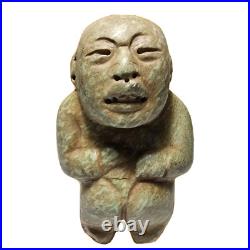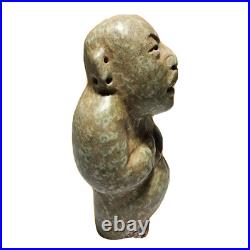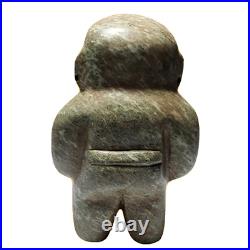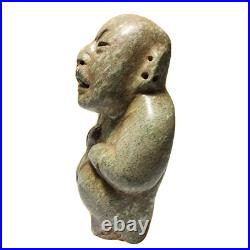




Extremely Rare Pre-Columbian Jade Olmec Figure. 900 – 500 BCE. Provenance: Amiguet’s Ancient Art, Evansville, Indiana, USA. Measurements: 5 3/4 tall. This is a relatively significantly sized piece, in all dimensions. Pre-Columbian, Southern Mexico to Guatemala, Olmec, ca. 900 to 500 BCE. An exquisite, finely-carved jade piece. Hallmark Olmec features on the characteristically elongated head include drilled almond-shaped eyes with pupils, a naturalistic nose, an open mouth with upturned lips characteristic of were-jaguars, and tab-shaped ears. The elongated head is a figural depiction of ritualistic cranial deformation. The attention to detail on this piece is rather impressive. A superb sculptural work from the Olmec, replete with sumptuous colors and expert artistry! Inspected under UV light, 10x loupe, and acetone tested. Natural inclusions, fissures, or divots within the stone throughout. Minor surface abrasions evident under loupe, as is typical with age. Overall in attractive and stable condition. The value of jade for ancient people lay in its symbolic power: perhaps its color was associated with water and vegetation; later, the Maya would place jade beads in the mouths of the dead. Many scholars have argued that the demand for jadeite contributed to the rise of long-distance trading networks and to the rise of urban centers in ancient Mesoamerica. This would have been an exceedingly valuable and rare jadeite figure. Scholars believe that Olmec artwork was revered by later civilizations that kept pieces as heirlooms. The Olmec style is famous for its anthropomorphic depictions and became synonymous with elite status in the highlands. They created enormous stone heads, probably the first thing many people think of when remembering the Olmec, but they also made handheld figures like this one as personal totems or divinities created for display in homes or certain types of temples. The piece is priced for a fraction of acquisition costs due to the passing of a prominent collector. This is a rare opportunity to acquire an extremely rare ancient fine art piece at a deal. Best offers will be strongly considered. The Olmecs are generally considered to be the ultimate ancestor of all subsequent Mesoamerican civilizations. Thriving between about 1200 and 400 BC, their base was the tropical lowlands of south central Mexico, an area characterized by swamps punctuated by low hill ridges and volcanoes. Here the Olmecs practiced advanced farming techniques and constructed permanent settlements, including San Lorenzo Tenochtitlán, La Venta, Tres Zapotes, Laguna de los Cerros, and La Mojarra. However, the consolidation of their city- states led to notable cultural influence far beyond their heartland, and throughout the Mesoamerican region. This was confirmed in 2005 with the use of NAA (Neutron Activation Analysis) and petrography to demonstrate the spread of Olmec ceramic vessels. A non- literate group, the Olmecs nevertheless paved the way for the development of writing systems in the loosely defined Epi- Olmec period c. Further innovations include arguably the first use of the zero, so instrumental in the Maya long count vigesimal calendrical system. They also appear to have been the originators of the famous Mesoamerican ballgame so prevalent among later cultures in the region, and either retained or invented several religious symbols such as the feathered serpent and the rain spirit, which persisted in subsequent and related cultures until the middle ages. Comparatively little is known of their magico- religious world, although the clues that we have are tantalizing. The art forms for which the Olmecs are best known, the monumental stone heads weighing up to forty tons, are generally assumed to pertain to some form of kingly leader or possibly an ancestor. The smaller jade figures and celts are believed to be domestically or institutionally based totems or divinities. The quality of production is astonishing, particularly if one considers the technology available for production, the early date of the pieces, and the dearth of earlier works upon which the Olmec sculptors could draw. Some pieces are highly stylized, while others demonstrate striking naturalism with interpretation of some facial features (notably down-turned mouths and slit eyes). Mesoamerica is home to a wide and diverse range of individuals, each marking the land with their unique style and culture – one of those being the Olmec’s. The Olmec people resided during the formative period in Mesoamerica, as early as 1500BCE to about 400BCE, is now modern Mexico and Guatemala. Olmec Art is often seen as some of the most stylistically beautiful. Often simple and considered “naturalistic”, the artwork carries across themes and traits specific to its people. They depicted cleft heads, were sometimes anamorphic, baby-faced, and with full curled lips, the works of art by the Olmec were simple yet highly elegant. One of the more abundant creations found, were the Olmec figurines. Widely spread across Mesoamerica, the styles of the figures are Olmec in origin, which were often found in graves and households. These figures were simple, presenting minimal characteristics and were almost exclusively nude. They were often made from terracotta, jade, greenstone and other mineral stones. The “baby faced” figures, have puffy slit eyes, full lips that curl at the ends, and chubby bodies. They are typically naked lacking genitalia; more emphasis is given to their faces rather than their overall bodies. They are generally quite small, roughly ranging at ten inches in height. Their purpose to Olmec culture is unknown, however one would assume it to be significant based on the sheer number of figurines found. Another example of the Olmec figures is the elongated man. Stiffly standing, it lacks great detail just like the “baby-faced” figures. It retains the same puffy-like slit eyes and curled lips. These figures however have thin limbs and flat topped elongated bald heads. They can be clothed at times, and if anything, they have a loin cloth represented by lines scratched into the material; same goes for toes and fingers. Holes penetrate their small ears, which suggest the figures were at one point possibly adorned with jewelry or fabric. The “transformation” figures are also popular for the Olmec’s. The “Were-jaguar” was popular mythology at the time and were often represented as if in mid transformation. They were baby-like in appearance, with almond shaped eyes, human noses and a snarling mouth with curled lips. The figures are frequently shown with clefts on the head, cross bars, or adorned with headdresses. They range from almost fully human to practically entirely animal, however managing to retain distinctive features as mentioned before. Their purpose is unknown, with suggestions ranging from religious, stylistic or artistic preference. However, they have managed to retain the charm they must have possessed so long ago, as they still captivate with their simple eloquence. This item is in the category “Antiques\Ethnographic\Latin American”. The seller is “antiqueauctionsinc” and is located in this country: US. This item can be shipped to United States.

